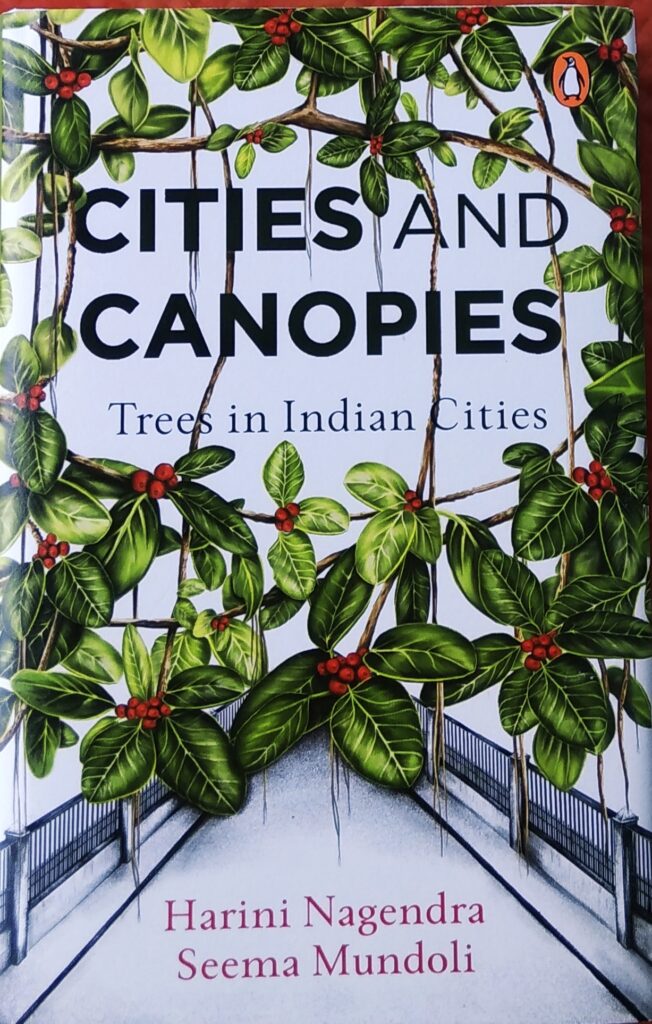Bhaskar Parichha

First things first: the title of the book and its cover. Together, they are fascinating and eye-catching, to say the least. Harini Nagendra and Seema Mundoli’s book has been extensively reviewed and that gives an idea about the merit of the book. In so far as one could write a whole book on trees in Indian cities with loads of information is doubly reassuring.
‘Cities and Canopies – Trees in Indian Cities’ is not just a book on plants, it is much more than that. It is a delicious account of the foliage, the vegetation, and the shrubbery that every Indian city takes pride in. Fruitfully written and with a purpose, the book is an ensemble of poetry, folk tales, history, mythology and therapeutic properties of the trees every Indian city takes pride in. The hardback – divided into twenty-five chapters and profusely illustrated – is an entrancing story of the evolution of plant life in cities and how people in towns and cities have grown up with these vegetations.
Harini who is a professor of sustainability at Azim Premji University has intensely delved into the interface between people, nature, forests, and cities for over twenty-five years and has written a couple of other books relating to the subject. Seema – a senior lecturer at the same University – has worked with NGOs involved in conservation, mining, land and forest rights, and education in indigenous communities besides studying the relationship between people and nature in cities. With such strong backgrounds and being passionate about trees, the authors have come up with a book that is part education, part ecology and the for the most part dealing with urban history.
Without making the book theoretical and sophistic, the author duo has tried to present the factoids relating to foliage in an extremely readable fashion. It is refreshing, reflective and at the same time evocative. The book juxtaposes the habits, tastes, cultural patterns and the customary love for trees in the urban setting. ‘Cities and Canopies’ is not a long way around to understand botany and the loaded tales behind a wide range of trees that adore Indian cities. The book maps the environmental and cultural histories of trees in our cities told in an urbane language. It is a trip down memory lane!
Tamarind, for example, is an integral part of both Indian culture and food. The tree has survived the vagaries of time. Or take the scarlet red silk cotton tree that undergoes an incredible transformation in the pre-monsoon season from its winter look. Its flowers, bark, fruit, gum, leaf, root and even the spiny prickles on the trunk are used to prepare herbal and ayurvedic medicines. The legendary banyan tree – with its thick aerial roots that grow from branches to eventually penetrate the ground – is India’s national tree and a sight to behold. While the authors have discussed at length the genesis of the trees and how they have been imbibed into our lives, there is a botanical account at the end of every chapter along with their gastronomy.
A familiar sight in many backyards, the drumstick (mooringa) is a powerhouse of nutrients — vitamins, minerals, and amino acids. For this very reason, the humble tree, says the book, is a superfood globally and its extracts-based cosmetics and skin/haircare products sell like hot cakes in the market. The amaltas tree and its spectacular golden blossoms post-spring too looks like a canopy. It was a predominant part of the Indian culture, from north to south and even finds a reference in Sangam literature. The book has all this and more: the Peepul tree, the Neem tree and, of course, the Palm tree.

Says the blurb, ‘Native and imported, sacred and ordinary, culinary and floral, favorites of various kings and commoners over the centuries, trees are the most visible signs of nature in cities, fundamentally shaping their identities. Trees are storehouses of the complex origins and histories of city growth, coming as they do from different parts of the world, brought in by various local and colonial rulers. From the tree planted by Sarojini Naidu at Dehradun’s clock tower to those planted by Sher Shah Suri and Jahangir on Grand Trunk Road, trees in India have served, above all, as memory keepers. They are our roots: their trunks our pillars, their bark our texture and their branches our shade. Trees are nature’s own museums.’
With urban ecosystem becoming a smoldering topic and as the scale of metropolitan change in India burgeons, conservation and knowledge about the flora and fauna are of paramount importance. It is estimated that by 2030 nearly 600 million Indians will live in cities, and 70 percent of new employment will be generated there. For India’s young and mobile population, cities are irreversible magnets—for livelihood, and for their aspirations. So, transforming Indian cities sustainable and environmentally healthy is a big task that governments, entrepreneurs, educational institutions and innovators will face in the coming decades. It is here that books like this one are ready to lend a hand.
The beauty and ingenuity of this book is the extensive research. The authors have taken care to deal with the specific and general aspects of the trees which double up as places of sunshade and fruit-yield. The book combines scientific diligence with anecdotes and civilizing landmarks. The painstaking work both the authors have done to highlight the connotation and significance of trees in India’s urban life is amazing.
Books like ‘Cities and Canopies’ are a painful reminder of the importance of trees and the famished contours of our urban landscape.
Cities and Canopies
Harini Nagendra & Seema Mundoli
Penguin Random House India
7th Floor,Infinity Tower,DLF Cyber City
Gurgaon 122002
Rs 499





























